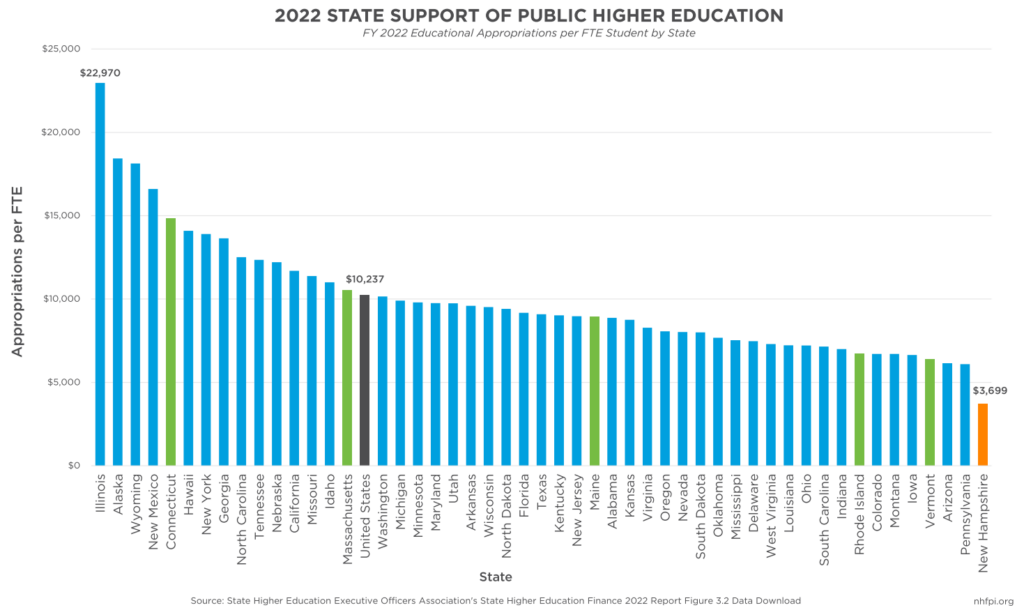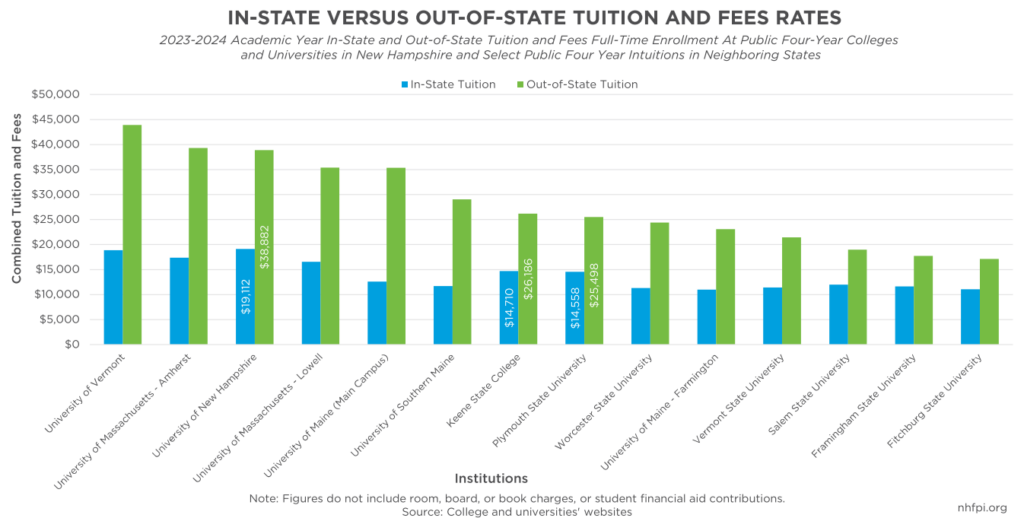Three of the five occupations with the largest projected ten-year growth in New Hampshire are in fields that require college degrees, including registered nurses, general and operations managers, and software developers. Given the need for workers in jobs that require college degrees, access to public higher education for Granite Staters is key, as is its affordability. Despite this need, New Hampshire ranks as one of the lowest funders of public higher education among the fifty U.S states.
New Hampshire State Public Higher Education Funding Lowest in Country
In fiscal year 2022, New Hampshire appropriated the lowest amount of funding to public higher education of all fifty states at $3,699 per full-time equivalent student (FTE). Illinois had the highest appropriation at $22,970 per FTE, while the national average was $10,237.
For every person in New Hampshire, the State budgeted $106 for public higher education in fiscal year 2023. Nationwide, state government support for public higher education averaged $338 per capita. To fund public higher education in New Hampshire at the same rate as the national average, the State Budget would have needed to increase funding by $232 per capita, to over three-fold the actual levels, resulting in a total higher education appropriation of more than $464 million, approximately $318 million higher than what was appropriated in 2023.
Limited State Funding Increases Costs for Students
In the 2023-2024 academic year, New Hampshire’s public four-year institutions had the highest in-state tuition and fees among neighboring states. Combined tuition and fees ranged from $14,558 at Plymouth State University to $19,112 at the University of New Hampshire’s main campus in Durham. Public four-year institutions in neighboring states had in-state tuition and fees that ranged between $11,046 at Fitchburg State University to $18,890 at the University of Vermont. New Hampshire’s four-year institutions also have some of the highest regional out-of-state tuition rates among public colleges and universities in New England, making recruitment of students challenging in the highly competitive Northeastern U.S. higher education market, where the decline in K-12 students has resulted in a significant decrease in enrollment for postsecondary institutions.
Consequences of Low State Funding of Public Higher Education
Low state funding of higher education may contribute to young Granite Staters leaving the state to pursue more affordable higher education opportunities. The most recent available data from the U.S. Department of Education revealed that, in 2020, 56 percent of New Hampshire high school graduates seeking four-year degrees left the state for their education. The Granite State is second only to Vermont on this metric. While Vermont, like New Hampshire, is a geographically small state, it also has relatively low state funding for public higher education. Of all the New England states, Maine had the lowest rate, 38 percent, of high school graduates bound for four-year colleges attending out-of-state institutions. In 2020, Maine appropriated $7,838 per FTE student enrolled at a four-year institution compared to New Hampshire’s $2,494.
Low state funding for public higher education may also contribute to higher student loan debt. Graduates from New Hampshire’s colleges and universities who have higher education loan debt carry the highest average debt, at $39,950, compared to all other graduates with student loan debt in the country. Additionally, New Hampshire ranks second for the highest percentage of graduates (70 percent) with student debt. Nationally, student debt is not equally distributed across racial and ethnic groups, with many graduates of color typically carrying higher debt burdens than white graduates.
Making college degrees more affordable in New Hampshire for in- and out-of-state students may be a key component to addressing workforce constraints. With an aging population, New Hampshire risks losing young, college-educated workers who are needed for a robust, diversified workforce that helps enable strong economic growth and enhanced well-being in the state. For more analysis and citations, see NHFPI’s November 2023 Issue Brief Limited State Funding for Public Higher Education Adds to Workforce Constraints.


